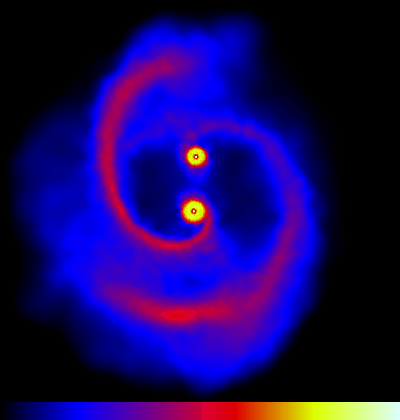Evolution of an Accreting Protobinary System 2This animation shows the evolution of a young binary star system that is still deeply embedded in the molecular cloud core in which it is forming (i.e. a Class 0 object). The binary system accretes gas from its envelope and increases its total mass. It is assumed that the binary formed via fragmentation of the collapsing cloud, although this stage is not modelled. In this calculation, it was assumed that the original molecular cloud core was centrally-condensed (with a 1/r density profile) and in solid-body rotation before it began to collapse. This sets the specific angular momentum of the gas that is accreted by the binary after it forms. The specific angular momentum of the gas is greater than in the first animation of an accreting protobinary system . At the beginning of the calculation the specific angular momentum of the infalling gas is already great enough for circumstellar discs to be formed around both the primary and secondary. Later, as the specific angular momentum of the gas that is falling on to the binary increases, a circumbinary disc forms. The circumbinary disc becomes more and more massive as more gas settles into it. This results in strong spiral density waves passing through the disc. The binary manages to accrete gas from the disc via accretion streams. Results from this calculation were published in Bate 2000 (Section 3.4 and Figures 5 and 6).
|

